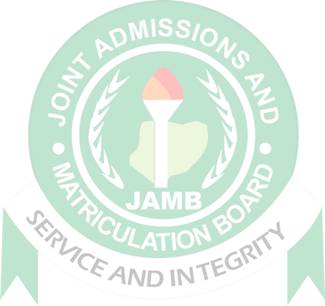
Mathematics (Core)
Paper 1 | Objectives | 47 Questions
JAMB Exam
Year: 1985
Level: SHS
Time:
Type: Question Paper
Answers provided
FREE
No description provided
Feedbacks
This paper is yet to be rated

Paper 1 | Objectives | 47 Questions
JAMB Exam
Year: 1985
Level: SHS
Time:
Type: Question Paper
Answers provided
No description provided
This paper is yet to be rated
Tips to make the best study space and quality time for studies are essential.
Middle East and North Africa MENA Scholarship Program (MSP) initiative provides scholarships
Five revision strategies that are strange but effective for memorization for high exams performance
| # | Question | Ans |
|---|---|---|
| 1. |
If three numbers P, Q, R are in ratio 6 : 4 : 5, find the value of \(\frac{3p - q}{4q + r}\) A. \(\frac{3}{2}\) B. \(\frac{2}{3}\) C. 2 D. 3 E. 18
Show Content
Detailed SolutionP : Q : r = 6 : 4 : 55 = 6 + 4 + 5 = 15 P = \(\frac{6}{15}\), q = \(\frac{4}{15}\), r = \(\frac{5}{15}\) = \(\frac{1}{3}\) To find \(\frac{3p - q}{4q + r}\) 3p - q = 3 x \(\frac{6}{15}\) - \(\frac{4}{15}\) \(\frac{18}{15}\) - \(\frac{4}{15}\) = \(\frac{14}{15}\) ∴ 4q + r = 4 x \(\frac{4}{15}\) + \(\frac{5}{15}\) \(\frac{16}{15}\) = \(\frac{16}{15}\) + \(\frac{5}{15}\) = \(\frac{21}{15}\) \(\frac{14}{15}\) x \(\frac{15}{21}\) = \(\frac{14}{21}\) = \(\frac{2}{3}\) |
|
| 2. |
Arrange the following numbers in ascending order of magnitude \(\frac{6}{7}\), \(\frac{13}{15}\), 0.8650 A. \(\frac{6}{7}\) < 0.865 < \(\frac{13}{15}\) B. \(\frac{13}{15}\) < \(\frac{6}{7}\) < 0.865 C. \(\frac{6}{7}\) < \(\frac{13}{15}\) < 0.865 D. 0.865 < \(\frac{6}{7}\) < \(\frac{13}{15}\)
Show Content
Detailed Solution\(\frac{6}{7}\), \(\frac{13}{15}\), 0.8650In ascending order, we have 0.8571, 0.8650, 0.8666 i.e. \(\frac{6}{7}\) < 0.8650 < \(\frac{13}{15}\) |
|
| 3. |
A sum of money was invested at 8% per annum simple interest. If after 4 years the money amounts to N330.00. Find the amount originally invested A. N180.00 B. n165.00 C. N150.00 D. N250.00 E. N200.00
Show Content
Detailed SolutionS.I = \(\frac{PTR}{100}\)T = 4yrs, R = 8%, a = N330.00 330 - P = \(\frac{PTR}{100}\), A = P + I i.e. A = P + \(\frac{PTR}{100}\) 330 = P + \(\frac{P(4) (8)}{100}\) 33000 = 32P + 100p 132P = 33000 P = N250.00 |
|
| 4. |
In the equation below, Solve for x if all the numbers are in base 2: \(\frac{11}{x}\) = \(\frac{1000}{x + 101}\) A. 101 B. 11 C. 110 D. 111 E. 10
Show Content
Detailed Solution\(\frac{11}{x}\) = \(\frac{1000}{x + 101}\) = 11(x + 101)1000x = 11x + 1111 1000x - 11x = 1111 101x = 1111 x = \(\frac{1111}{101}\) x = 11 |
|
| 5. |
List all integers satisfying the inequality -2 \(\leq\) 2 x -6 < 4 A. 2, 3, 4, 5 B. 2, 3, 4 C. 2, 5 D. 3, 4, 5 E. 4, 5
Show Content
Detailed Solution-2 \(\leq\) 2x - 6 < 4 = 2x - 6 < 4= 2x < 10 = x < 5 2x \(\geq\) -2 + 6 \(\geq\) = x \(\geq\) 2 ∴ 2 \(\leq\) x < 5 [2, 3, 4] |
|
| 6. |
Find correct to two decimals places 100 + \(\frac{1}{100}\) + \(\frac{3}{1000}\) + \(\frac{27}{10000}\) A. 100.02 B. 1000.02 C. 100.22 D. 100.01 E. 100.51
Show Content
Detailed Solution100 + \(\frac{1}{100}\) + \(\frac{3}{1000}\) + \(\frac{27}{10000}\)\(\frac{1000,000 + 100 + 30 + 27}{10000}\) = \(\frac{1,000.157}{10000}\) = 100.02 |
|
| 7. |
John gives one-third of his money to Janet who has N105.00. He then finds that his money is reduced to one-fourth of what Janet now has. Find how much money john has at first A. N45.00 B. N48.00 C. N52.00 D. N60.00 E. N52.00
Show Content
Detailed SolutionLet x be John's money, Janet already had N105, \(\frac{1}{3}\) of x was given to JanetJanet now has \(\frac{1}{3^2}\)x + 105 = \(\frac{x + 315}{3}\) John's money left = \(\frac{2}{3}\)x = \(\frac{\frac{1}{4}(x + 315)}{3}\) = \(\frac{2}{3}\) 24x = 3x + 945 ∴ x = 45 |
|
| 8. |
Find x if log\(_9\)x = 1.5 A. 72.0 B. 27.0 C. 36.0 D. 3.5 E. 24.5
Show Content
Detailed SolutionIf log\(_9\)x = 1.5,9\(^1.5\) = x 9^\(\frac{3}{2}\) = x (√9)\(^3\) = 3 ∴ x = 27 |
|
| 9. |
Write h in terms of a, b, c, d if a = \(\frac{b(1 - ch)}{a - dh}\) A. h = \(\frac{a - b}{ad}\) B. h = \(\frac{1 - b}{ad - bc}\) C. h = \(\frac{(a - b)^2}{ad - bc}\) D. h = \(\frac{a - b}{ad - bc}\) E. h = \(\frac{b - a}{ab - dc}\)
Show Content
Detailed Solutiona = \(\frac{b(1 - ch)}{a - dh}\)a = \(\frac{b - bch}{1 - dh}\) = a - adh = b - bch a - b = bch + adn a - b = adh a - b = h(ad - bc) h = \(\frac{a - b}{ad - bc}\) |
|
| 10. |
22\(\frac{1}{2}\)% of the Nigerian Naira is equal to 17\(\frac{1}{10}\)% of a foreign currency M. What is the conversion rate of the M to the Naira? A. 1M = 1\(\frac{15}{57}\)N B. 1M = 38\(\frac{1}{4}\)N C. 1M = 1\(\frac{18}{57}\)N D. 1M = 384\(\frac{3}{4}\)N
Show Content
Detailed SolutionN = 22\(\frac{1}{2}\)%, M = 17\(\frac{1}{10}\)%M = \(\frac{171}{10}\)%, N = \(\frac{45}{2}\) \(\frac{45}{2}\) x \(\frac{10}{171}\) = \(\frac{225}{171}\) = 1 \(\frac{54}{171}\) = 1 \(\frac{18}{57}\) |
Preview displays only 10 out of the 47 Questions